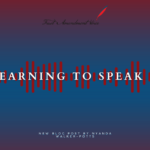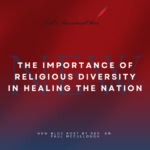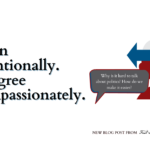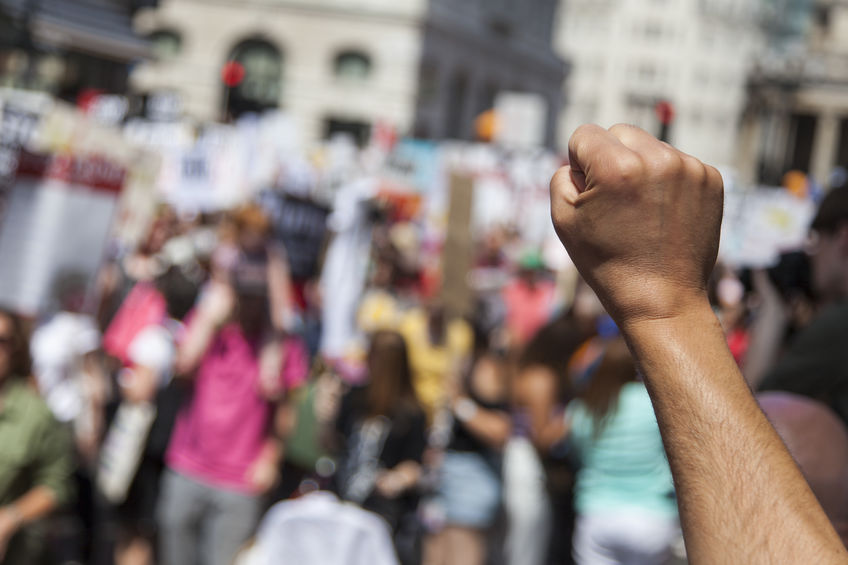
by Dan | May 8, 2019 | Uncategorized
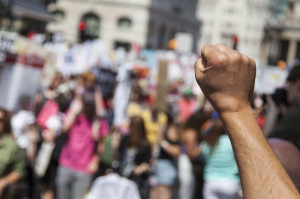 Everyone knows about freedom of speech, the press and religion in the First Amendment, but surveys have shown that a majority of Americans either don’t know or forget that the freedom to petition and to peacefully assemble are also included in the First Amendment. While “peaceful assembly” may refer to public congregations of individuals for any reason, public protests are most commonly associated with our freedom to assemble.
Everyone knows about freedom of speech, the press and religion in the First Amendment, but surveys have shown that a majority of Americans either don’t know or forget that the freedom to petition and to peacefully assemble are also included in the First Amendment. While “peaceful assembly” may refer to public congregations of individuals for any reason, public protests are most commonly associated with our freedom to assemble.
In an era of online petitions, digital boycotts of companies, and other forms of cyber-activism, are public protests still effective when it comes to changing social beliefs or political systems? As this opinion piece at Ideas.TED.com points out, there are plenty of ways to build a successful social movement, and you might be surprised to learn just how successful some protests are these days.
Increasing Public Awareness
Thanks to the Internet, we’ve come a long way from the 1960s and 1970s protests against the Vietnam War, which didn’t necessarily end the war but did transform public opinions about the war. Nowadays, we still see small-scale, local protests and large marches, but we’re also witnessing globalized movements on an unprecedented scale.
Take the March 15, 2019, global student strike for climate change: started by a 16-year-old Swedish girl, the student walkout encompassed more than 990 schools across 90+ countries, largely thanks to social media organizing. The purpose behind the strike was to generate greater public awareness (and concern) for climate change, which teenagers and young adults say will negatively impact them the most because they will be on Earth for decades longer than their parents and grandparents’ generations.
Organization, Messaging & Nonviolence
Research conducted by The Washington Post journalists found that successful protests typically share 3 traits: they’re well-organized, they have an appealing message, and they do not resort to violence.
On the issue of organization, it’s important that prominent organizers of a protest or movement share similar ideals and goals to avoid dividing their cause into separate factions. An example of this is the Standing Rock protests against the Dakota Access Pipeline project in 2016. The protests were largely organized by social media-savvy young adults and their communities, which helped them centralize their platform and ultimately persuade the Army Corps of Engineers to deny a construction permit to the would-be pipeline builders (that decision was later reversed under the Trump Administration and lawsuits remain to this day).
On the issue of messaging, a protest’s message(s) should resonate with a wide range of people, beyond just those directly involved in the protest itself. An example of this would be the recent teacher strikes around the United States, which started over concerns related to low pay, overcrowded classes, few classroom resources, and limited support from administrators and districts. Since a majority of Americans attended public schools when they were younger and millions more want the same high-quality educational opportunities for their own children, the messages underlying the teachers’ strikes resonated with a massive audience.
On the issue of nonviolence, successful protests are able to maintain public support by encouraging participants to refrain from violence, verbal harassment, and other socially unacceptable forms of expression. An example of this would be the “lactivist” protests at Applebee’s in 2007, in which breastfeeding mothers protested against the restaurant’s discriminatory policies (making women breastfeed their infants in a restroom stall, when most states have already legalized public breastfeeding). This nonviolent display of protest ultimately led Applebee’s to issue a statement that it would be more welcoming of nursing mothers in the future.
Are Protests Really Effective?
Many protests start out strong then fizzle out due to a variety of intergroup or situational issues, but at the end of the day, it’s not always about whether protests are effective or ineffective. Instead, we should remember that peaceful protests are part of our Constitutionally-guaranteed First Amendment rights, and protecting those rights is something we should all agree on.

by Dan | Apr 24, 2019 | Uncategorized
 Chick-Fil-A seems to come up in national news headlines every couple years or so, and 2019 is no different. Two cities recently prohibited Chick-Fil-A from operating in their airports on the basis of what they claim are discriminatory stances the company has taken in its policies and corporate donations. Let’s explore the issue further to see which side might hold more weight in the courtroom:
Chick-Fil-A seems to come up in national news headlines every couple years or so, and 2019 is no different. Two cities recently prohibited Chick-Fil-A from operating in their airports on the basis of what they claim are discriminatory stances the company has taken in its policies and corporate donations. Let’s explore the issue further to see which side might hold more weight in the courtroom:
Background
As with any major controversy, there are at least two sides to the story. On one hand, ThinkProgress uncovered financial reports that found Chick-fil-a donated at least $1.8 million to nonprofits with anti-LGBT beliefs and/or policies in 2017. This support of anti-LGBT groups has prompted local government councils in San Antonio, TX and Buffalo, NY to deny or revoke approval to open locations in their airport terminals on the basis of Chick-Fil-A’s alleged support of discriminatory nonprofit organizations.
On the other hand, the decisions by government entities to deny Chick-Fil-A the ability to operate at government-regulated airports may contradict First Amendment protections. As of April, the Texas Attorney General’s office is now investigating San Antonio’s decision.
Free Speech for Corporations
The 2010 Supreme Court decision in Citizens United v. Federal Election Commission granted some free speech protections to corporations (also commonly referenced as “corporate personhood”). Under this line of logic, Chick-Fil-A should be free to donate to whichever groups it wants without retribution from the government.
In the case of Chick-Fil-A’s operating permit being revoked in Buffalo, NY, even the progressive American Civil Liberties Union (ACLU) is siding with Chick-Fil-A in the dispute. As the NYCLU Assistant Director for Legislative Affairs Erika Lorshbough said, “government actors cannot officially silence speech or take punitive actions based on a person’s or private entity’s political viewpoints.”
The debate over corporate personhood and the clash between progressive/conservative government entities and their conservative/progressive challengers will remain important First Amendment issues for many years to come. In the meantime, what do you think? Should restaurants be free to operate wherever they want, or should government be able to bar those that support causes the governmen rejects?

by Dan | Apr 10, 2019 | Uncategorized
 The Internet is often a chaotic and relatively unregulated public sphere, but this doesn’t necessarily mean that you can say or post anything you want without consequences. Although our public officials have been debating the extent to which the government can regulate speech and expression online for years, there remains a lot of vagueness surrounding First Amendment protections online, particularly when it comes to social media.
The Internet is often a chaotic and relatively unregulated public sphere, but this doesn’t necessarily mean that you can say or post anything you want without consequences. Although our public officials have been debating the extent to which the government can regulate speech and expression online for years, there remains a lot of vagueness surrounding First Amendment protections online, particularly when it comes to social media.
There have been multiple legal cases involving social media posts however, so at least there are judicial precedents from which we can reasonably determine what speech is protected by the First Amendment and what speech would be considered illegal. Here are a few situations in which the right to freedom of expression isn’t as absolute as you might think:
Violating the Terms & Conditions for Users
People often forget that the First Amendment only protects individuals against government censorship or punishment of their speech. This does not mean that Facebook, Twitter, Youtube, Instagram or other social sites are required by law to allow any and all expressions by users on their platforms. By agreeing to the site’s terms and conditions during the sign-up process, users are consenting to abide by each platform’s unique rules and if someone is banned for violating these rules, then that doesn’t necessarily constitute a First Amendment violation.
Furthermore while these social platforms are regulated by the Federal Communications Commission, the current regulations are woefully out-of-date. Perhaps some of the terms and conditions are unfair to users, but until the FCC re-examines its own regulations for social networking sites, the issue of possible First Amendment rights violations will remain up for debate.
Incriminating Information
Did you know that people have been arrested for what they posted on social media? Regardless of whether you’re serious or joking, law enforcement generally treats online threats similarly to verbal threats uttered offline and even threatening emojis can be used as warrants for arrest. Social media users also have been arrested for admitting to hit-and-runs in posts on their personal profiles, as well as driving under the influence of alcohol or drugs.
If you think it’s just basic common sense to know what to post and what not to post on social media, then you might be surprised to learn that one teenager took a selfie with the corpse of a friend he had killed and posted it on SnapChat. Obviously this is an extreme example, but other, lesser criminal offenses brought to light by social media demonstrate the necessity of developing our digital literacy skills and being mindful of legal constraints when posting on social media.
Fired Because of a Social Media Post
As noted previously, the First Amendment primarily protects individuals against the government infringing on their rights to freedom of speech and expression. Since private sector employers are exempt from this (and many employees nowadays are considered “at-will”), this means you could potentially get fired for what you post on social media, even if it’s not illegal.
There are plenty of stories about people who got fired over social media posts, and few wrongful termination lawsuits filed by these folks have been successful in court. This is why it’s important not just to understand what’s legal and illegal on social media, but also what your employer’s social media guidelines are.
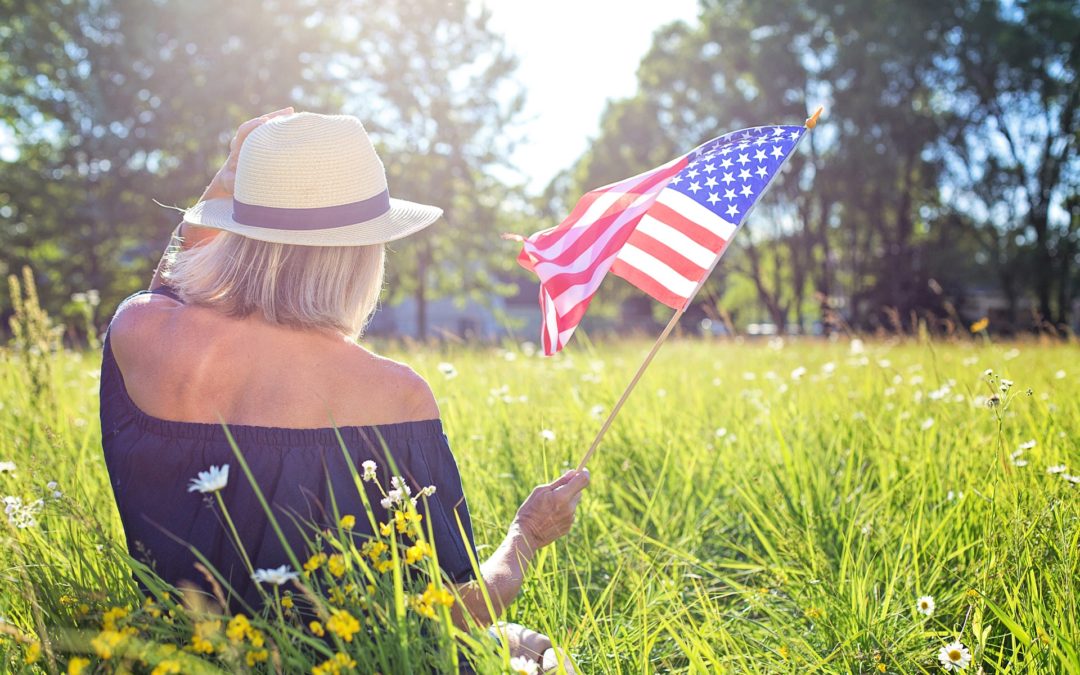
by Dan | Mar 19, 2019 | Newsletter, Uncategorized
Reflections on our first amendment freedoms in a foreign country
As I prepare to leave Amman, following a fruitful visit writing some final thoughts in a forthcoming book, visiting a friend, and seeing nonprofit field operations in action, I paused to reflect on the current state of discourse in our country. We live in a partisan environment where identity politics overrules civility to our fellow human being, where students have begun to mobilize against what they deem as older generational failure to address existential threats (climate change, student debt, post-college employment, the national debt, racism, gun violence and more), where more people have begun tuning out network news (on the right and left), where fear and apathy push voices out of the public square, but where many civic organizations and leaders encourage people to constructively contribute to important conversations in their communities.
Jordan has many more refugees and challenges of immigration than the United States. The vast majority of people inside its borders do not have equal rights. Few believe they can express their fears and be heard. Jordanians blame Iraqis for having spiked rents, and other prices more generally, during the waves of displacement that occurred during the conflict in Iraq. Palestinians feel they will never hold the same job prospects as their Jordanian countrymen, even though many have been here for fifty years. The freedom to assemble and petition the government for grievance pales next to the vibrancy in the United States, yet you would never know comparing the atmosphere here.
Jordan is a model of stability for the region. Jordanians go about their everyday lives. Many have significant grievances. I spent time interacting with nonprofits dealing in the refugee space, learning about the extreme biases and challenges that refugees face. They are not allowed to work. Many can’t afford to put their children through school. They spend their time agonizing over basic necessities, Maslow’s hygiene needs at the lowest level of the hierarchy.
Contrast the relative calm in Jordan to the tumultuous climate in the United States, and I believe it comes from a vibrant citizenry, not only aware of its rights but freely exercising them. A substantial portion of the population has awakened to the threat of losing their rights, whether freely practicing their religion, stating their beliefs, or other means of expression. The very tenor and clamor of expression in the U.S. leads me to assess that citizens and institutions are pushing back against perceived threats. It may be messy. It may sound noisy and shrill, but it may just exhibit the traits of those fundamental rights, granted by a Creator, freely expressed by individuals against perceived state infringements or ineptitude.
So, as much as I am an introvert by nature and need quiet and solitude to recharge my batteries, I take heart from the noise. I see leaders stepping up to start blog conversations, leading coffee talk discussion groups, and engaging their civic institutions to ensure their voices are heard. I may continue to seek my news from late night comedy or podcasts, but I’ll laugh at the comedy while reveling in the idea that democracy lives in the United States, practiced by its people and institutions on a daily basis. That’s a nice thought to come home to, in addition to rejoining my family after some time apart.
Citizenship is not a spectator sport! If you like our newsletter, please share with a friend!
Steve
VOTE now in the FedEx Small Business Grant Contest
Do you want to help students attend the next National Symposium in September? Please vote to help FAV sponsor students this year. SLC supports student involvement in citizenship and professional research opportunities. Be a part of helping young men and women learn more about their country and be involved in meaningful engagement in their communities.
Mark Your Calendars
April 6th – Coffee Talk, Coronado, CA SIGN UP HERE
May 10th – Global LA Summit w/ Pacific Council on International Policy
May 11th – Difficult Conversations workshop w/ Kern Beare, LA

by Dan | Mar 13, 2019 | Uncategorized
 In today’s hyper-polarized political climate, you oftentimes hear people bemoan what our Founding Fathers would think if they came back to see what had become of the U.S. two centuries later. However, a quick glimpse at history reveals several parallels between the late 1700s and the early 2000s of today:
In today’s hyper-polarized political climate, you oftentimes hear people bemoan what our Founding Fathers would think if they came back to see what had become of the U.S. two centuries later. However, a quick glimpse at history reveals several parallels between the late 1700s and the early 2000s of today:
Treason Accusations
Former acting director of the FBI recently revealed that he and Deputy Attorney General Rod J. Rosenstein considered invoking the 25th Amendment to remove Donald Trump from the office of the presidency on the basis of being “unable to discharge” his duties as Commander-in-Chief.
This revelation led Trump to respond on Twitter:
“The biggest abuse of power and corruption scandal in our history, and it’s much worse than we thought. Andrew McCabe (FBI) admitted to plotting a coup (government overthrow) when he was serving in the FBI, before he was fired for lying & leaking.” @seanhannity @FoxNews Treason!
Regardless of whether McCabe’s statement and previously intended-but-not-taken actions constitute treason, the Founding Fathers wouldn’t be too surprised by the latest political brawl because it happened so many times in the late 1700s and early 1800s. The original Alien and Sedition Acts themselves were so poorly phrased that almost anything could be labeled treasonous, and the Sedition Act of 1918 (which was really just an amendment to the Espionage Act) vaguely prevented any “disloyal, profane, scurrilous, or abusive language” towards the U.S. government, flag or armed forces.
“Fake News”
As the Smithsonian points out, “fake news” rhetoric has been around since America was born – it just wasn’t called “fake news” back then. A notable example from the Founding Fathers’ time would be the Aurora, published and run by Benjamin Franklin’s grandson, Benjamin Bache. Based in Philadelphia, the Aurora frequently printed articles lambasting and harshly criticizing President Adams, who grew to dislike the notion of a free press, stating, “there has been more new error propagated by the press in the last ten years than in an hundred years before 1798.”
Nowadays, things haven’t improved much. We still have actual fake news spreading misinformation to millions of people online, as well as “fake news” rhetoric utilized by politicians to discredit news stories and/or media outlets publishing information that they, their parties and supporters dislike or disagree with. Fortunately, there are plenty of tools and organizations (like First Amendment Voice) to protect the public against waves of misinformation while simultaneously upholding our vital First Amendment rights to freedom of speech and freedom of the press.
Wealthy-Backed Media
In the 1700s and early 1800s, it wasn’t uncommon for wealthy political figures to fund (secretly or publicly) journalists and publications that supported their political views. For example, Thomas Jefferson was known to privately fund journalists like James Callender, who aggressively supported political agendas Jefferson believed in (anti-Federalist).
Nowadays, prominent, ultra-wealthy individuals like Amazon’s Jeff Bezos (owner of The Washington Post) and Roger Ailes (1940-2017; Chairman and CEO of Fox News) likely have considerable influence over the press, though media organizations strive to maintain objectivity in their reporting as much as possible.
All in all, you might be surprised to see just how similar our First Amendment-related concerns are to the concerns of our Founding Fathers’ generation, back when the First Amendment was first established. This doesn’t mean we should give up and assume we’re doomed to repeat history, of course. Visit our donations page to help us fight for all Americans’ First Amendment freedoms today.
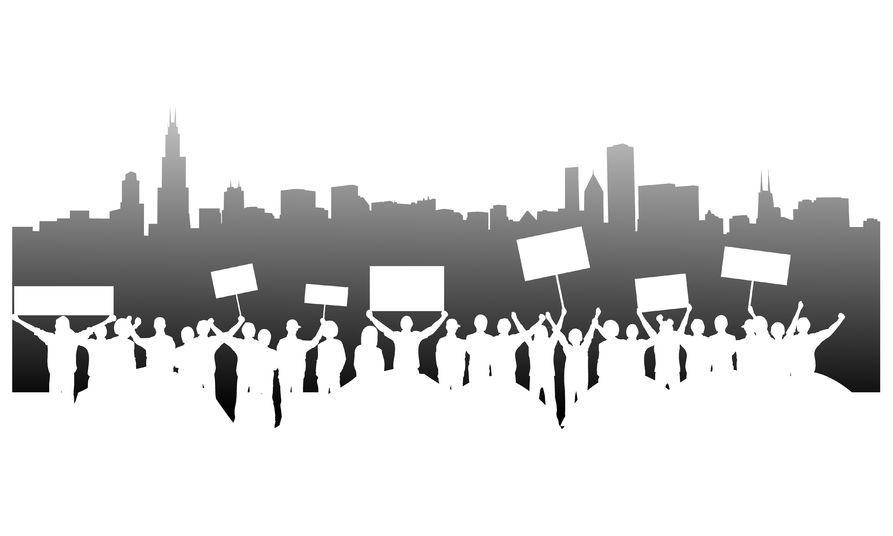
by Dan | Feb 27, 2019 | Uncategorized
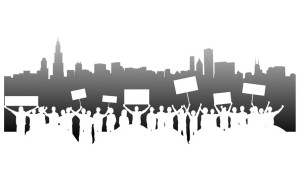 When you think of the First Amendment, freedom of speech, freedom of religion and freedom of the press typically come to mind. By comparison, the freedoms to petition and peacefully assemble are frequently forgotten by American citizens asked about their First Amendment rights in surveys and informal polls. Why is that?
When you think of the First Amendment, freedom of speech, freedom of religion and freedom of the press typically come to mind. By comparison, the freedoms to petition and peacefully assemble are frequently forgotten by American citizens asked about their First Amendment rights in surveys and informal polls. Why is that?
There is a long, complicated history behind our Constitutional right to peacefully assemble, but it’s not as well known as some of the other freedoms guaranteed by the First Amendment because this is something that may not directly affect us on a daily basis. While many people assume this simply refers to the unrestricted right to protest, the reality is actually much more complex than you might think.
As the Library of Congress points out, the government cannot prohibit its citizens from congregating in public spaces, whether that entails participation in protests and marches or attending public meetings. Over time, this right has bolstered public marches, rallies, and student protests.
Nowadays, the freedom to peacefully protest is closely intertwined with our rights to freedom of speech and even freedom of religion in some cases. For instance, citizens are able to collectively amplify their voices and potentially spark socio-political change in ways that simply wouldn’t be possible if we were forced to articulate our opinions and ideas in isolation from other people who may be receptive to them.
Of course, it’s worth noting that the right to peaceful assembly is not absolute, nor is it easy to interpret under the law. There have been several legal challenges related to the question of what constitutes a “peaceful” protest, and which types of assembly may be considered dangerous, threatening, or chaotic. This is why many protest organizers need to acquire permits before a protest may take place in public. That can help the local/state/federal government to adequately prepare for a larger-than-usual public presence and properly secure the area with law enforcement, in cases of conflict between protestors and counter-protestors.
Additionally, the government may limit when and where a protest or rally may be held for the purpose of minimizing disruptions to public life. For instance, a loud, chaotic protest that clogs the streets during rush hour in a large urban area may not meet the criteria for a “peaceful” form of assembly.
Although you may not think about your right to peaceful assembly as much as you’re aware of the freedoms to speak freely and practice any religion you choose, it’s nevertheless an important right that all Americans ought to remember when it comes to the First Amendment.

 Everyone knows about freedom of speech, the press and religion in the First Amendment, but surveys have shown that a majority of Americans either don’t know or forget that the freedom to petition and to peacefully assemble are also included in the First Amendment. While “peaceful assembly” may refer to public congregations of individuals for any reason, public protests are most commonly associated with our freedom to assemble.
Everyone knows about freedom of speech, the press and religion in the First Amendment, but surveys have shown that a majority of Americans either don’t know or forget that the freedom to petition and to peacefully assemble are also included in the First Amendment. While “peaceful assembly” may refer to public congregations of individuals for any reason, public protests are most commonly associated with our freedom to assemble.

 Chick-Fil-A seems to come up in national news headlines every couple years or so, and 2019 is no different. Two cities recently prohibited Chick-Fil-A from operating in their airports on the basis of what they claim are discriminatory stances the company has taken in its policies and corporate donations. Let’s explore the issue further to see which side might hold more weight in the courtroom:
Chick-Fil-A seems to come up in national news headlines every couple years or so, and 2019 is no different. Two cities recently prohibited Chick-Fil-A from operating in their airports on the basis of what they claim are discriminatory stances the company has taken in its policies and corporate donations. Let’s explore the issue further to see which side might hold more weight in the courtroom:
 The Internet is often a chaotic and relatively unregulated public sphere, but this doesn’t necessarily mean that you can say or post anything you want without consequences. Although our public officials have been debating the extent to which the government can regulate speech and expression online for years, there remains a lot of vagueness surrounding First Amendment protections online, particularly when it comes to social media.
The Internet is often a chaotic and relatively unregulated public sphere, but this doesn’t necessarily mean that you can say or post anything you want without consequences. Although our public officials have been debating the extent to which the government can regulate speech and expression online for years, there remains a lot of vagueness surrounding First Amendment protections online, particularly when it comes to social media.

 In today’s hyper-polarized political climate, you oftentimes hear people bemoan what our Founding Fathers would think if they came back to see what had become of the U.S. two centuries later. However, a quick glimpse at history reveals several parallels between the late 1700s and the early 2000s of today:
In today’s hyper-polarized political climate, you oftentimes hear people bemoan what our Founding Fathers would think if they came back to see what had become of the U.S. two centuries later. However, a quick glimpse at history reveals several parallels between the late 1700s and the early 2000s of today:
 When you think of the First Amendment, freedom of speech, freedom of religion and freedom of the press typically come to mind. By comparison, the freedoms to petition and peacefully assemble are frequently forgotten by American citizens asked about their First Amendment rights in surveys and informal polls. Why is that?
When you think of the First Amendment, freedom of speech, freedom of religion and freedom of the press typically come to mind. By comparison, the freedoms to petition and peacefully assemble are frequently forgotten by American citizens asked about their First Amendment rights in surveys and informal polls. Why is that?

